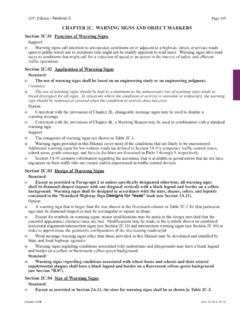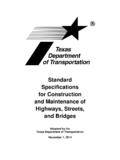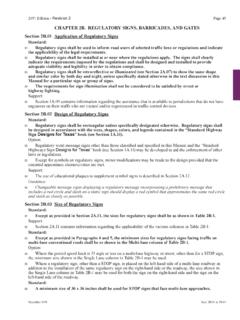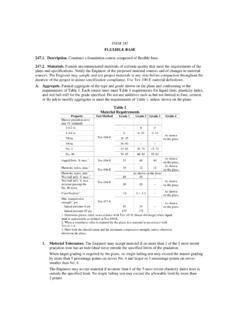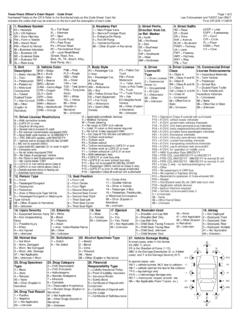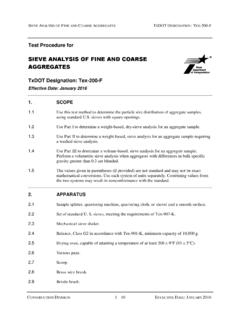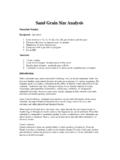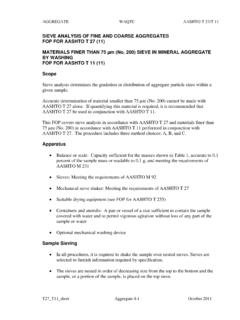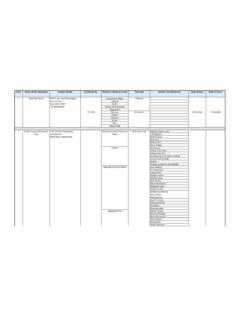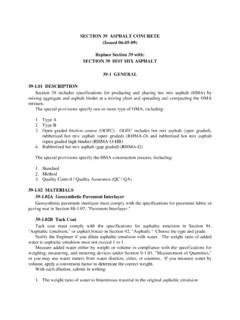Transcription of PARTICLE SIZE ANALYSIS OF SOILS - ftp.dot.state.tx.us
1 PARTICLE size ANALYSIS OF SOILS TXDOT DESIGNATION: TEX-110-E. Test Procedure for PARTICLE size ANALYSIS OF SOILS . TxDOT Designation: Tex-110-E. Effective Date: August 1999. 1. SCOPE. This method covers the quantitative determination of the distribution of PARTICLE sizes in SOILS . The distribution of PARTICLE sizes larger than 75 m (No. 200) is determined by sieving, while the distribution of PARTICLE sizes smaller than 75 m is determined by a sedimentation process, using a hydrometer to secure the necessary data. If hydrometer ANALYSIS is not required, but a determination of material passing the 75 m (No. 200) sieve is desired, refer to Tex-401-A for low Plasticity Index (PI) materials or Tex-111-E for clay materials. The values given in parentheses (if provided) are not standard and may not be exact mathematical conversions. Use each system of units separately.
2 Combining values from the two systems may result in nonconformance with the standard. PART I sieve ANALYSIS OF MATERIAL RETAINED ON THE 425 M. (NO. 40) sieve . 2. SCOPE. Part I details the necessary steps for sieve ANALYSIS of material retained on the 425 m (No. 40) sieve . 3. APPARATUS. Drying oven, maintained at 110 5 C (230 9 F). Mechanical sieve shaker. Balance, Class G2 in accordance with Tex-901-K, minimum capacity of 15 kg (33 lb.). Sample splitter, quartering machine, or quartering cloth. Standard sieves, meeting the requirements of Tex-907-K. Pans. CONSTRUCTION DIVISION 1 13 LAST REVIEWED: JULY 2016. PARTICLE size ANALYSIS OF SOILS TXDOT DESIGNATION: TEX-110-E. 4. SAMPLES. The mass of sample should be sufficient for PARTICLE size ANALYSIS . The minimum amount required of material retained on the 425 m (No. 40) sieve depends on the maximum PARTICLE size .
3 The size should not be less than the amount shown in Table 1. When the nominal maximum size is between sizes shown, use next larger minimum mass. Table 1 Mass Requirement for sieve ANALYSIS Nominal Maximum size Approximate Minimum Mass mm (3/8 in.) kg (1 lb.). 25 mm (1 in.) 2 kg (4 lb.). mm (1-1/2 in.) 4 kg (8 lb.). 50 mm (2 in.) 5 kg (10 lb.). 75 mm (3 in.) 6 kg (12 lb.). Note 1 The size of the portion passing the 425 m (No. 40) sieve should be: for the hydrometer test, approximately 100 g for sandy soil and approximately 50 g for silty or clayey SOILS . for hygroscopic moisture determination, at least 10 g. 5. PROCEDURE. Prepare a sample of material for ANALYSIS in accordance with Tex-101-E, Method A). Record the mass of the material passing the 425 m (No. 40) sieve ( soil binder) as WS. under Section 6. Obtain all sieve sizes required by the material specification.
4 Stack sieves in descending order with the sieve having the largest opening on top and a pan on the bottom. Pour the plus (+) 425 m (No. 40) portion of the sample into the sieves. Use a mechanical shaker and shake the sieves for five minutes. After shaking, remove the top sieve from the stack without losing any of the retained material. Over a clean pan, hand sieve until not more than one percent, by weight, of the material retained on the sieve continues to pass through the sieve . Combine any material passing the sieve with the material retained on the next smallest size sieve . Weigh the portion retained on the first sieve and record the mass as W1 under Section 6. Repeat Section for the next largest sieve size and then add the material retained to the portion retained on the first sieve and record the combined weight as W2 under Section 6. Continue hand sieving and recording the combined masses, as W3, W4, etc.
5 , until all sieving is complete. CONSTRUCTION DIVISION 2 13 LAST REVIEWED: JULY 2016. PARTICLE size ANALYSIS OF SOILS TXDOT DESIGNATION: TEX-110-E. 6. CALCULATIONS. Calculate the total mass of the sample: WT WS W. Where: WT = total mass of sample, g WS = mass of material passing the 425 m (No. 40) sieve , g W = cumulative mass of smallest sieve size , g. Calculate cumulative percent retained for each sieve : Cumulative % Re tained first sieve 100 W1 WT. Cumulative % Re tained sec ond sieve 100 W2 WT ,etc. Calculate individual percent retained for each sieve by subtracting the cumulative percent retained of one sieve size larger from the cumulative percent retained of the sieve size : Individual % Re tained of W2 of W1 , etc. Plot the cumulative percent retained, from above, versus the sieve size , on , Cumulative Mechanical ANALYSIS tab or on semi-logarithmic paper.
6 Table 2 sieve ANALYSIS Calculations sieve size Cumulative Weight Cumulative Individual Percent Retained (g) Percent Retained Retained mm (1/2 in.) mm (3/8 in.) mm (No. 4) mm (No. 8) Total including minus (-) 425 m 100. (No. 40) material 7. TEST REPORT. Report the individual percent retained on each sieve to the nearest whole number. CONSTRUCTION DIVISION 3 13 LAST REVIEWED: JULY 2016. PARTICLE size ANALYSIS OF SOILS TXDOT DESIGNATION: TEX-110-E. PART II HYDROMETER ANALYSIS OF SOILS PASSING 425 M. (NO. 40) sieve . 8. SCOPE. This part describes the ANALYSIS of SOILS passing the 425 m (No. 40) sieve using a hydrometer. 9. APPARATUS. Balance, Class G1 in accordance with Tex-901-K, minimum capacity of 200 g. Stirring apparatus, either a mechanical stirring device or an air dispersion device, as shown in Figure 1. Hydrometer, graduated in grams per liter, Type 151 H or 152 H, as shown in Figure 3.
7 Sedimentation cylinder, a glass hydrometer cylinder approximately 457 mm (18 in.) in height and mm ( in.) in diameter, graduated for a volume of 1000 mL, as shown in Figure 2. Mercury thermometer, range of 0 104 C (1 220 F), accurate to C (1 F). Standard sieves, meeting the requirements of Tex-907-K in the following sizes: 75 mm (3 in.). 50 mm (2 in.). 25 mm (1 in.). mm (3/8 in.). mm (No. 4). 2 mm (No. 10). 425 m ( No. 40). 75 m (No. 200). Oven, maintained at 110 5 C (230 9 F). Evaporating dishes. Water bath, or constant temperature room. Timing device, with a second hand. Beaker, 250 mL ( oz.). CONSTRUCTION DIVISION 4 13 LAST REVIEWED: JULY 2016. PARTICLE size ANALYSIS OF SOILS TXDOT DESIGNATION: TEX-110-E. Figure 1 Mechanical Stirring Device Figure 2 Air Dispersion Device CONSTRUCTION DIVISION 5 13 LAST REVIEWED: JULY 2016. PARTICLE size ANALYSIS OF SOILS TXDOT DESIGNATION: TEX-110-E.
8 Figure 3 Hydrometer with Dimensions 10. MATERIAL. Dispersing agent, a solution of sodium hexametaphosphate in distilled or demineralized water, at the rate of 40 g of sodium hexametaphosphate per liter of solution. Solution of this salt, if acidic, should be slowly reverted or hydrolyzed back to the orthophosphate form with a resultant decrease in dispersing action. Solutions should be prepared frequently (at least once a month) or adjusted to pH of 8 or 9 by means of sodium carbonate. Bottles containing solutions should have the date of preparation marked on them. Distilled or demineralized water. Source of compressed air, if air dispersion device is used. 11. DETERMINING COMPOSITE CORRECTION FOR HYDROMETER. READING. Equations for percentages of soil remaining in suspension, as given in Section 13 are based on the use of distilled or demineralized water.
9 CONSTRUCTION DIVISION 6 13 LAST REVIEWED: JULY 2016. PARTICLE size ANALYSIS OF SOILS TXDOT DESIGNATION: TEX-110-E. A dispersing agent is used in the water, however, and the specific gravity of the resulting liquid is appreciably greater than that of distilled or demineralized water. The manufacturer calibrates the soil hydrometers at 20 C (68 F), and variations in temperature from this standard temperature produce inaccuracies in the actual hydrometer readings. The amount of the inaccuracy increases as the variation from the standard temperature increases. The manufacturer graduates hydrometers to be read at the bottom of the meniscus formed by the liquid on the stem. Since it is not possible to secure readings of soil suspensions at the bottom of the meniscus, readings must be taken at the top and a correction applied. The net amount of the corrections for the three items enumerated is designated as the composite correction, and may be determined experimentally.
10 For convenience, a graph or table of composite corrections for a series of one-degree temperature differences for the range of expected test temperatures may be prepared and used as needed. Measurement of the composite corrections may be made at two temperatures spanning the range of expected test temperatures, and corrections for the intermediate temperatures calculated assuming a straight-line relationship between the two observed values. Prepare 1000 mL (30 fl. oz.) of liquid composed of distilled water and dispersing agent in the same proportion as will prevail in the sedimentation (hydrometer) test. Place the liquid in a sedimentation cylinder and the cylinder in the constant-temperature water bath, set for one of the two temperatures to be used. When the temperature of the liquid becomes constant, insert the hydrometer at the top of the meniscus formed on the stem.


